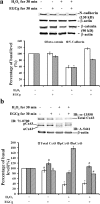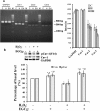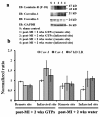Epigallocatechin-3-gallate-mediated cardioprotection by Akt/GSK-3β/caveolin signalling in H9c2 rat cardiomyoblasts
- PMID: 24251870
- PMCID: PMC3871020
- DOI: 10.1186/1423-0127-20-86
Epigallocatechin-3-gallate-mediated cardioprotection by Akt/GSK-3β/caveolin signalling in H9c2 rat cardiomyoblasts
Abstract
Background: Epigallocatechin-3-gallate (EGCg) with its potent anti-oxidative capabilities is known for its beneficial effects ameliorating oxidative injury to cardiac cells. Although studies have provided convincing evidence to support the cardioprotective effects of EGCg, it remains unclear whether EGCg affect trans-membrane signalling in cardiac cells. Here, we have demonstrated the potential mechanism for cardioprotection of EGCg against H2O2-induced oxidative stress in H9c2 cardiomyoblasts.
Results: Exposing H9c2 cells to H2O2 suppressed cell viability and altered the expression of adherens and gap junction proteins with increased levels of intracellular reactive oxygen species and cytosolic Ca2+. These detrimental effects were attenuated by pre-treating cells with EGCg for 30 min. EGCg also attenuated H2O2-mediated cell cycle arrest at the G1-S phase through the glycogen synthase kinase-3β (GSK-3β)/β-catenin/cyclin D1 signalling pathway. To determine how EGCg targets H9c2 cells, enhanced green fluorescence protein (EGFP) was ectopically expressed in these cells. EGFP-emission fluorescence spectroscopy revealed that EGCg induced dose-dependent fluorescence changes in EGFP expressing cells, suggesting that EGCg signalling events might trigger proximity changes of EGFP expressed in these cells. Proteomics studies showed that EGFP formed complexes with the 67 kD laminin receptor, caveolin-1 and -3, β-actin, myosin 9, vimentin in EGFP expressing cells. Using in vitro oxidative stress and in vivo myocardial ischemia models, we also demonstrated the involvement of caveolin in EGCg-mediated cardioprotection. In addition, EGCg-mediated caveolin-1 activation was found to be modulated by Akt/GSK-3β signalling in H2O2-induced H9c2 cell injury.
Conclusions: Our data suggest that caveolin serves as a membrane raft that may help mediate cardioprotective EGCg transmembrane signalling.
Figures







Similar articles
-
Molecular identification for epigallocatechin-3-gallate-mediated antioxidant intervention on the H2O2-induced oxidative stress in H9c2 rat cardiomyoblasts.J Biomed Sci. 2014 Jun 9;21(1):56. doi: 10.1186/1423-0127-21-56. J Biomed Sci. 2014. PMID: 24913014 Free PMC article.
-
5-AIQ inhibits H2O2-induced apoptosis through reactive oxygen species scavenging and Akt/GSK-3β signaling pathway in H9c2 cardiomyocytes.Toxicol Appl Pharmacol. 2013 Apr 1;268(1):90-8. doi: 10.1016/j.taap.2013.01.004. Epub 2013 Jan 23. Toxicol Appl Pharmacol. 2013. PMID: 23352507
-
The extract of Gnaphalium affine D. Don protects against H2O2-induced apoptosis by targeting PI3K/AKT/GSK-3β signaling pathway in cardiomyocytes.J Ethnopharmacol. 2021 Mar 25;268:113579. doi: 10.1016/j.jep.2020.113579. Epub 2020 Nov 12. J Ethnopharmacol. 2021. PMID: 33189844
-
The protective effect of hispidin against hydrogen peroxide-induced apoptosis in H9c2 cardiomyoblast cells through Akt/GSK-3β and ERK1/2 signaling pathway.Exp Cell Res. 2014 Oct 1;327(2):264-75. doi: 10.1016/j.yexcr.2014.07.037. Epub 2014 Aug 14. Exp Cell Res. 2014. PMID: 25128810
-
Epigallocatechin Gallate for Management of Heavy Metal-Induced Oxidative Stress: Mechanisms of Action, Efficacy, and Concerns.Int J Mol Sci. 2021 Apr 14;22(8):4027. doi: 10.3390/ijms22084027. Int J Mol Sci. 2021. PMID: 33919748 Free PMC article. Review.
Cited by
-
Catechin relieves hypoxia/reoxygenation-induced myocardial cell apoptosis via down-regulating lncRNA MIAT.J Cell Mol Med. 2020 Feb;24(3):2356-2368. doi: 10.1111/jcmm.14919. Epub 2020 Jan 19. J Cell Mol Med. 2020. PMID: 31955523 Free PMC article.
-
Comparison of Metabolomics Approaches for Evaluating the Variability of Complex Botanical Preparations: Green Tea (Camellia sinensis) as a Case Study.J Nat Prod. 2017 May 26;80(5):1457-1466. doi: 10.1021/acs.jnatprod.6b01156. Epub 2017 Apr 28. J Nat Prod. 2017. PMID: 28453261 Free PMC article.
-
Oxidative Stress Response Is Mediated by Overexpression and Spatiotemporal Regulation of Caveolin-1.Antioxidants (Basel). 2020 Aug 18;9(8):766. doi: 10.3390/antiox9080766. Antioxidants (Basel). 2020. PMID: 32824727 Free PMC article.
-
Dysregulation of Caveolin-1 Phosphorylation and Nuclear Translocation Is Associated with Senescence Onset.Cells. 2021 Oct 28;10(11):2939. doi: 10.3390/cells10112939. Cells. 2021. PMID: 34831162 Free PMC article.
-
Molecular identification for epigallocatechin-3-gallate-mediated antioxidant intervention on the H2O2-induced oxidative stress in H9c2 rat cardiomyoblasts.J Biomed Sci. 2014 Jun 9;21(1):56. doi: 10.1186/1423-0127-21-56. J Biomed Sci. 2014. PMID: 24913014 Free PMC article.
References
Publication types
MeSH terms
Substances
LinkOut - more resources
Full Text Sources
Other Literature Sources
Molecular Biology Databases
Research Materials
Miscellaneous

